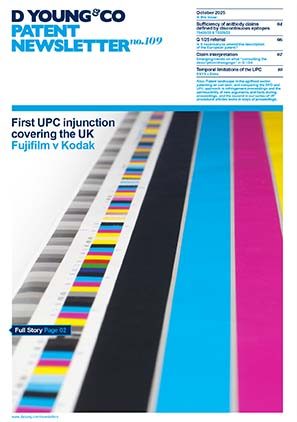Can we finally advance? CJEU asked once again to consider SPC eligibility of patents for combination products
The Irish Supreme Court has referred a number of questions to the Court of Justice of the European Union (CJEU) on issues relating to the eligibility of combination medicinal products for protection by supplementary protection certificates (SPCs). The referral has the potential to decide Europe-wide litigation on a combination product and provide some much-needed clarity to a matter which has vexed courts in the EU for over a decade.
Background
In EU and EEA countries (as well as the UK and some other European countries), SPCs provide an extension of the term of patents for pharmaceuticals and plant protection products which require a marketing authorisation (regulatory approval) before they can be placed on the market. The aim of SPCs is to, at least partially, restore some of the patent term during which a product cannot be marketed because of the need to obtain regulatory approval. An SPC is limited in scope to the authorised product, and can last for up to five years, with a further six months’ extension available if paediatric studies are carried out on the approved pharmaceutical. SPCs are therefore critical to the research-based pharmaceutical industry, with every additional day of term extension being worth millions of dollars.
As part of the criteria for SPC eligibility, Article 3(a) of the SPC Regulation (469/2009) requires that the approved product be “protected” by a basic patent in force. However, the precise meaning of “protected” has been the subject of fiercely contested litigation in Europe for over a decade. Despite multiple references to the CJEU on this question, there is still a considerable lack of clarity on exactly what is required for the approved product to be “protected” by the basic patent. Three possible tests for compliance with Article 3(a) have been considered by the courts:
- The “infringement” test: under this test, it is simply sufficient that the approved product falls within the claims of the basic patent, with no additional criteria.
- The “specifically identifiable” (or “identified” or “specified”) test: under this test, the approved product must not only fall within the claims of the basic patent, but also be sufficiently identifiable (preferably as a specific compound) within the claims and/or description of the basic patent.
- The “inventive advance” (or “invention” or “sole subject-matter of the patent”) test: under this test, the approved product must also reflect the inventive contribution made by the patent.
Neither of tests 2 or 3 have any specific legal basis in the wording of the SPC Regulation. However, like all EU legislation, the SPC Regulation is interpreted in line with its aims and objectives (a so-called “teleological” interpretation). Both tests 2 and 3 can be considered to have their basis in the doctrine that the SPC should reflect the research that led to the basic patent, and should exclude from SPC protection products which had not been invented at the filing date of the basic patents. For example, the case law discussed below appears to have the intention of excluding SPCs based on patents where a biological target of a particular disease had been identified but drugs acting on it had not yet been invented. In relation to the issue of combination patents specifically, the case law appears to try to exclude the grant of an SPC to a combination where a drug had been discovered to work as a mono-product but combination products containing it had yet to be invented.
Prior CJEU case law on SPCs
For most of the first 20 years of SPCs in Europe, test 1 was largely considered to be the sole test relevant for interpreting Article 3(a) of the SPC Regulation. However, in Medeva (C-322/10), the CJEU specifically rejected an “infringement” test when ruling that a SPC for a combination vaccine product was invalid, and introduced test 2 into EU SPC case law for the first time. Subsequent CJEU decisions, in Actavis v Sanofi (C-433/12) and Actavis v Boehringer (C-577/13) confirmed this test and additionally introduced a version of test 3 in also rejecting combination product SPCs.
In Teva v Gilead (C-121/17), the CJEU was once again asked to consider the validity of SPCs for combination products. The court laid down a two-part test for whether a combination product met the requirements of Article 3(a), as follows:
(i) the combination of actives necessarily, in the light of the description and drawings of that patent, fall under the invention covered by the patent, and
(ii) each of those active ingredients must be “specifically identifiable”, in the light of all the information disclosed by the patent, at the filing or priority date of the application.
Part (ii) of the Teva test corresponds to test 2 outlined above. However, the CJEU notably did not use the term “inventive advance” in deciding Teva. This raised the question whether test 3 was still relevant in deciding SPC eligibility under Article 3(a) – in particular, did “the invention” mean the same as test 3?
In Royalty Pharma (C-650/17), the CJEU affirmed the “specifically identifiable” test, and also ruled that a functional definition of the product in the basic patent did not meet Article 3(a) if the approved product was “developed after the filing or priority date of the basic patent, following an independent inventive step”. In that decision, the CJEU notably opined that the “core inventive advance” was not relevant in determining the compliance with Article 3(a) – but nevertheless quoted the wording of the two Actavis cases. This once again raised the issue of whether test 3 was still relevant for compliance with Article 3(a), or indeed whether the new test amounted to the same thing in different words.
The Merck v Clonmel litigation – ezetimibe and simvastatin
The case before the CJEU resulted from long-running litigation on a family of SPCs based on EP720599. The basic patent claimed the approved compound ezetimibe both generally and specifically, and also contained claims directed to combination products with statins, specifically reciting simvastatin. However, the patent contained no data showing the combination of ezetimibe and simvastatin (or any other combination partner) was independently inventive over and above ezetimibe as a mono-product.
Ezetimibe was first approved in Europe as a mono-product, and Merck obtained a first family of SPCs (SPC 1) based on the above basic patent and the mono-product approval. Subsequent to the grant of these SPCs, the combination of ezetimibe and simvastatin was separately approved, and Merck obtained a second family of SPCs (SPC 2) for this combination based on that approval and the same basic patent. The SPC 2 family was filed and, mostly, granted before Medeva and subsequent case law were decided by the CJEU.
Following expiry of the basic patent and the SPC 1 family, the generic pharmaceutical manufacturer Clonmel began to market a combination ezetimibe / simvastatin product. Merck sued them for infringement of the patent and SPC 2 family, and Clonmel counter-claimed for revocation of the SPC 2 family.
It was not in dispute that both ezetimibe and simvastatin were “specifically identified” in the basic patent and therefore test 2 was met. However, Clonmel argued that SPC 2 was invalid on two grounds. First, they argued that test 3 was not met and SPC 2 therefore did not comply with Article 3(a). Second, they argued that the grant of SPC 1 before SPC 2 was filed precluded the grant of SPC 2 under Article 3(c), which requires that the approved product not already be the subject of an SPC.
Merck counter-argued that the “inventive advance” approach had been specifically rejected by the CJEU in Royalty Pharma, and therefore test 3 was no longer required to be met for the patent to be eligible for SPC protection under Article 3(a). However, the Irish High Court favoured Clonmel’s arguments in finding SPC 2 invalid under both Articles 3(a) and 3(c), and the Irish Court of Appeal agreed.
Differing decisions were reached in parallel litigation in courts across Europe. The Belgian, Portuguese and Czech courts found SPC 2 valid. In Italy, although a decision has not yet been reached by the court, the majority of expert opinions advising the court have also considered it valid. However, the French courts found SPC 2 invalid under both Articles 3(a) and 3(c), and the German and Spanish courts found it invalid under Article 3(c) without reaching a decision under Article 3(a).
Questions referred to CJEU
In view of the uncertainty in the current case law and the widely differing views of European courts, the Irish Supreme Court decided to refer the matter to the CJEU. The questions raised were as follows:
“1.(a) For the purpose of the grant of an SPC, and for the validity of that SPC in law, under Article 3(a) of [the SPC Regulation], does it suffice that the product for which the SPC is granted is expressly identified in the patent claims, and covered by it; or is it necessary for the grant of an SPC that the patent holder, who has been granted a marketing authorisation, also demonstrate novelty or inventiveness or that the product falls within a narrower concept described as the invention covered by the patent?
1.(b) If the latter, the invention covered by the patent, what must be established by the patent holder and marketing authorisation holder to obtain a valid SPC?
2. Where, as in this case, the patent is for a particular drug, ezetimibe, and the claims in the patent teach that the application in human medicine may be for the use of that drug alone or in combination with another drug, here, simvastatin, a drug in the public domain, can an SPC be granted under Article 3(a) of the Regulation only for a product comprising ezetimibe, a monotherapy, or can an SPC also be granted for any or all of the combination products identified in the claims in the patent?
3. Where a monotherapy, drug A, in this case ezetimibe, is granted an SPC, or any combination therapy is first granted an SPC for drugs A and B as a combination therapy, which are part of the claims in the patent, though only drug A is itself novel and thus patented, with other drugs being already known or in the public domain; is the grant of an SPC limited to the first marketing of either that monotherapy of drug A or that first combination therapy granted an SPC, A+B, so that, following that first grant, there cannot be a second or third grant of an SPC for the monotherapy or any combination therapy apart from that first combination granted an SPC?
4. If the claims of a patent cover both a single novel molecule and a combination of that molecule with an existing and known drug, perhaps in the public domain, or several such claims for a combination, does Article 3(c) of the Regulation limit the grant of an SPC;
(a) only to the single molecule if marketed as a product;
(b) the first marketing of a product covered by the patent whether this is the monotherapy of the drug covered by the basic patent in force or the first combination therapy, or
(c) either (a) or (b) at the election of the patentee irrespective of the date of market authorisation?
And if any of the above, why?”
The answers to questions 1 and 2 will likely decide the Article 3(a) issue in this litigation, and hopefully provide some clarity about whether test 3 is still relevant for determining compliance with Article 3(a). Questions 3 and 4 will likely decide the Article 3(c) issue.
The CJEU registry has entered this case onto its records as C-149/22, and the court will likely decide the case some time in 2023. After over a decade of uncertainty, can the court finally end its opaqueness on these issues and provide a clear ruling on SPC eligibility that both the research-based and generic pharmaceutical industries have been crying out for?
Of course, following Brexit, the UK courts are not bound by new decisions of the CJEU, and the UK Court of Appeal and UK Supreme Court are free to depart from existing CJEU case law. However, we expect that, at least for now, the UK courts will continue to follow SPC case law generated by the CJEU, and the outcome of the present referral therefore remains relevant to the UK, as well as to the rest of Europe.


